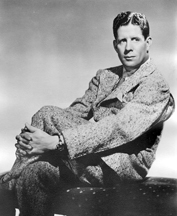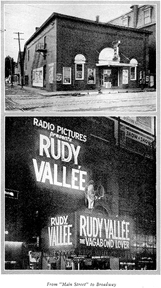In Chapter 16 of his 1930 memoir, Vagabond Dreams Come True, Rudy Vallée recounts his earliest experiences in the recording studio.
IT’S IN THE WAX
MAKING phonograph records always had a great fascination for me. My first thrill of hearing my voice in song or saxophone in solo came when i was at the University of Maine in 1921.
 The authorities of the University of Maine were interested enough in my musical efforts to allow me the use of some of the buildings on the campus for my practice. The agricultural part of the college had a large building known as Agricultural Hall where one learned all the science of the soil and animal life of the farm and barnyard. High up on the fourth floor were large classrooms that were empty at night. In one of these I used to practice certain very disagreeable sounding exercises. For instance, for the development of saxophone tone I started with the lowest note on the sax and held it as long as the deep breath I had just taken would permit. I have held certain notes of the saxophone for two minutes.
The authorities of the University of Maine were interested enough in my musical efforts to allow me the use of some of the buildings on the campus for my practice. The agricultural part of the college had a large building known as Agricultural Hall where one learned all the science of the soil and animal life of the farm and barnyard. High up on the fourth floor were large classrooms that were empty at night. In one of these I used to practice certain very disagreeable sounding exercises. For instance, for the development of saxophone tone I started with the lowest note on the sax and held it as long as the deep breath I had just taken would permit. I have held certain notes of the saxophone for two minutes.Of course nothing could be more monotonous or unpleasant to hear than these long tone exercises since it took me one hour to come up the scale, holding each note as long as possible. Therefore, to avoid driving others to insanity, I sought complete isolation where I had the comfortable feeling that I was disturbing no one and likewise would not be disturbed.
In some of the various offices on this floor were Ediphones, or dictaphones, as they are more commonly known. Since a letter dictated into one of these could be reproduced for the stenographer’s ear, I saw no reason why I could not likewise reproduce music; and so I recorded on these round dictaphone cylinders several simple melodies on the saxophone, announcing them very much in the fashion the old Edison cylinders announced the name of the record.
Although the dictaphone is perfected for the recording of speech in letter form, it is far from perfect when one attempts to record a sustained musical note on it. The rotation of the wax disc upon which a musical sound has been recorded must be absolutely perfect and the tube, or horn, which leads the sound to the needle that scratches upon the wax disc must be of a certain type and size to catch all of the notes being reproduced. The dictaphone being imperfect in this respect proved to be quite unsatisfactory for perfect reproduction of my musical efforts.
However, it still gave me some idea of phrasing, style and tone. I still have several of these old dictaphone cylinders stowed away and prize them very highly, perhaps as highly as some of our Victor records that today are so popular.
Easter vacation, 1922, saw my first chance to really record a saxophone solo The Victor Company had written me, in response to my letter inquiring about the possibility of recording a saxophone solo, that they had their saxophone artists and saw no opening for me.
However, the Edison Company, having no great saxophone artist, promised me an audition and a test recording.
The Columbia Phonograph Company maintains what is known as a Personal Record Department which will record, for the sum of fifty dollars, any vocal or instrumental sounds which can be recorded on a ten inch record, that plays for three minutes. This recording is done in the same room that the greatest of their artists use, on the same machines and with the same experts that devoted to these artists. Then they allow you the choice of one of two proofs, as in the case of proofs of photographs, and the one selected can be purchased singly at one dollar or in lots of 500 at fifty cents each.
It was worth fifty dollars to me (although that seemed a lot of money then), to go to New York and do this. So, I arranged a day during my Easter vacation of 1922 to perform a simple solo. I left Bangor, Maine, with three great objectives: first, to see and hear Paul Whiteman‘s orchestra at the Palais Royal, second, to meet Rudy Wiedoeft personally (as his manager had promised me an appointment) and third, to make my first solo record.
As the train stopped in New Haven for a few minutes and I saw those young college boys, dressed in the height of college fashion, I never dreamed that I would some day be on that same station platform, likewise a Yale man, and wearing the same type of clothes.
In New York, I realized every one of my ambitions. It was my first visit to the metropolis and I was duly impressed, as every small town person probably is.

